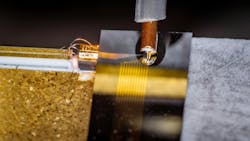Chipscale laser may be gamechanger for optical metrology and LiDAR
A new chipscale laser crafted of lithium niobate by a team of University of Rochester and University of California–Santa Barbara researchers is a tiny gamechanger (2 mm in width and ~2 cm in length) for optical metrology precision and powering LiDAR because it can provide extremely accurate measurements by changing its color across a broad spectrum of light ~10 quintillion times per second (see video).
The team selected lithium niobate for their laser—rather than silicon photonics—because it can leverage the Pockels effect, which changes the refractive index of a material when an electric field is present.
“We were inspired by the challenge of making optical measurement systems smaller, simpler, and more efficient,” says Shixin Xue, a graduate student working with Qiang Lin, a professor of electrical and chemical engineering and optics at the University of Rochester. “Traditional systems rely heavily on bulky external components, which limit their practical use and integration into compact and portable applications. We wanted to address these limitations and enable more widespread use of precision optical measurement technologies.”
The team’s laser integrates thin-film lithium niobate (TFLN) with semiconductor laser technology (III-V gain chip). “At its core is the electro-optic Pockels effect, which allows extremely rapid frequency modulation directly within the laser cavity,” Xue explains. “We also designed an extended distributed Bragg reflector (DBR) on a silica cladding to enable good side-mode suppression and narrow laser linewidth. This simplified structure significantly enhances tuning capabilities and reduces complexity to conventional designs.”
Their method involves integrating electrodes directly into the lithium niobate structure, which enables rapid and precise tuning of the laser frequency via electrical signals. “Our approach eliminates the need for external modulators and makes the system more compact and reliable,” Xue says. “It leverages the strong electro-optical properties of lithium niobate—and enables extremely high modulation speeds and frequency tuning capabilities.”
Optical metrology and LiDAR applications ahead
What does the team’s chipscale laser enable in terms of optical metrology and LiDAR? It significantly enhances the speed of LiDAR systems and enables highly accurate distance and velocity measurements. “For example, it can measure speeds up to tens of meters per second with centimeter-level distance resolution,” says Xue. “It also simplifies frequency stabilization for high-precision applications such as optical atom clocks, quantum sensors, and quantum computing by eliminating the need for complex external control setups.”
One of the most exciting moments for Xue and the team during this work was achieving an unprecedented frequency chirp rate—far beyond what they initially anticipated. “We initially anticipated a frequency chirp rate in the range of several petahertz per second (1015-1016 Hz/s),” says Xue. “But we achieved a significantly higher frequency chirp rate of ~2x1019 Hz/s, which was more than 100x faster than our initial expectations.” This result expanded their vision for potential applications that need high-frequency chirp rates.
“Achieving extremely narrow laser linewidth while maintaining stable single-mode operation during rapid frequency tuning was particularly challenging,” Xue points out. “It required meticulous optimization of the laser’s structural design, careful control of fabrication processes, and precise engineering of the integrated electrode structures. Overcoming these challenges was critical to achieving the exceptional performance demonstrated by our laser.”
Other key performance details of their chipscale laser include: An intrinsic linewidth as low as 167 Hz; a mode-hop-free tuning range up to 24 GHz; modulation frequency can reach the GHz level; and it achieved a long-term frequency stability of ±6.5 MHz during an hour using direct feedback locking with a gas-cell reference.
While LiDAR is already tapped by autonomous vehicles, next-gen frequency-modulated continuous-wave LiDAR will require a large tuning range of the laser’s frequency, which the team’s laser is designed to deliver. In a mini demo, the researchers showed their laser can drive a LiDAR system on a spinning disc and identify the letters U and R made out of LEGO blocks, which they believe can now be scaled up to detect vehicles and obstacles at highway speeds and distances.
Quick timeline
As far as a timeline, the team expects to pull off practical demonstrations of fully packaged systems within the next 1 to 2 years. After successful demonstrations, they anticipate broader adoption and more application-specific developments.
“Our immediate focus is on packaging everything together because it will enhance the mechanical stability and integration of the laser,” says Xue. “We also hope to find applications that can fit the ultrafast frequency chirp rate.”
This work is supported in part by the U.S. Defense Advanced Research Projects Agency’s (DARPA) Lasers for Universal Microscale Optical Systems program (with a mission to bring high-performance lasers and amplifiers to manufacturable photonics platforms through heterogeneous integration of diverse materials) and the National Science Foundation.
FURTHER READING
S. Xue et al., Light Sci. Appl., 14, 209 (2025); https://doi.org/10.1038/s41377-025-01872-4.
About the Author
Sally Cole Johnson
Editor in Chief
Sally Cole Johnson, Laser Focus World’s editor in chief, is a science and technology journalist who specializes in physics and semiconductors.


